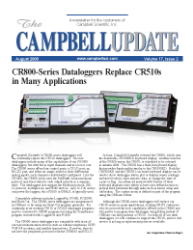Apogee Instruments (Logan, UT) has developed a new infrared radiometer, the IRR-P. Typical applications of this infrared radiometer include:
- Road surface temperature
- Plant canopy temperature for irrigation scheduling and crop water stress
- Soil, snow, and water surface temperatures
- Sky temperature (net longwave radiation)
The IRR-P provides four main advantages over the original model:
- The output follows the fundamental physics of the Stefan-Boltzman Law,which states that energy transfer by radiation is proportional to T4. The S-B equation is now used to correct for the effect of sensor body temperature. Sensor accuracy1 is significantly improved when the temperature difference between the sensor body and target exceeds ±20°C.
- The microvolt outputs of the original two thermocouples have been replaced with millivolt outputs of a thermopile and thermistor. This reduces the wire cost, increases accuracy, and is compatible with datalogger models that can not measure thermocouples (i.e., CR510). The internal reference temperature is now measured with a precision thermistor, which is accurately read with a single-ended measurement.
- A germanium window, which corresponds to the 8 to 14 μm atmospheric window, has replaced the silicon window (6.5 to 14 μm). This germanium window facilitates correction of target emissivity, reduces the effect of atmospheric humidity, and allows the IRR-P to be used at greater distances from the target.
- The IRR-P’s field of view is 22° (half-angle), which is narrower than the original sensor’s field of view. A narrower field of view allows the sensor to be mounted further away from the target.
Dimensions and mounts are identical to the original model. The IRR-P is mounted to a crossarm, tripod or tower mast, or a user supplied pole via the CM220 Right Angle Mounting Bracket or CM230 Adjustable Inclination Mount. The IRR-P should be mounted perpendicular to the target surface. Therefore, the CM230 mount is recommended when the target surface is on an incline.
See www.apogeeinstruments.com for more details.
1Accuracy
| -15° to 60°C | -55° to 80°C |
| ± 0.2°C absolute accuracy | ± 0.5°C absolute accuracy |
| ± 0.1°C uniformity and repeatability | ± 0.3°C uniformity and repeatability |

